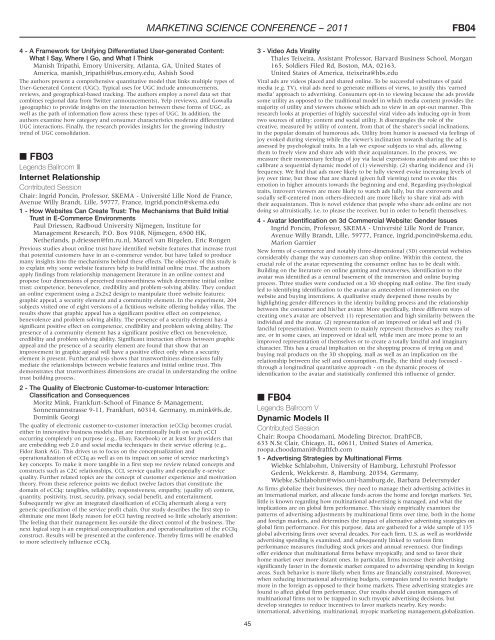Conference Sessions - Jesse H. Jones Graduate School of ...
Conference Sessions - Jesse H. Jones Graduate School of ...
Conference Sessions - Jesse H. Jones Graduate School of ...
Create successful ePaper yourself
Turn your PDF publications into a flip-book with our unique Google optimized e-Paper software.
4 - A Framework for Unifying Differentiated User-generated Content:<br />
What I Say, Where I Go, and What I Think<br />
Manish Tripathi, Emory University, Atlanta, GA, United States <strong>of</strong><br />
America, manish_tripathi@bus.emory.edu, Ashish Sood<br />
The authors present a comprehensive quantitative model that links multiple types <strong>of</strong><br />
User-Generated Content (UGC). Typical uses for UGC include announcements,<br />
reviews, and geographical-based tracking. The authors employ a novel data set that<br />
combines regional data from Twitter (announcements), Yelp (reviews), and Gowalla<br />
(geographic) to provide insights on the interaction between these forms <strong>of</strong> UGC, as<br />
well as the path <strong>of</strong> information flow across these types <strong>of</strong> UGC. In addition, the<br />
authors examine how category and consumer characteristics moderate differentiated<br />
UGC interactions. Finally, the research provides insights for the growing industry<br />
trend <strong>of</strong> UGC consolidation.<br />
■ FB03<br />
Legends Ballroom III<br />
Internet Relationship<br />
Contributed Session<br />
Chair: Ingrid Poncin, Pr<strong>of</strong>essor, SKEMA - Université Lille Nord de France,<br />
Avenue Willy Brandt, Lille, 59777, France, ingrid.poncin@skema.edu<br />
1 - How Websites Can Create Trust: The Mechanisms that Build Initial<br />
Trust in E-Commerce Environments<br />
Paul Driessen, Radboud University Nijmegen, Institute for<br />
Management Research, P.O. Box 9108, Nijmegen, 6500 HK,<br />
Netherlands, p.driessen@fm.ru.nl, Marcel van Birgelen, Eric Rongen<br />
Previous studies about online trust have identified website features that increase trust<br />
that potential customers have in an e-commerce vendor, but have failed to produce<br />
many insights into the mechanisms behind these effects. The objective <strong>of</strong> this study is<br />
to explain why some website features help to build initial online trust. The authors<br />
apply findings from relationship management literature in an online context and<br />
propose four dimensions <strong>of</strong> perceived trustworthiness which determine initial online<br />
trust: competence, benevolence, credibility and problem-solving ability. They conduct<br />
an online experiment using a 2x2x2 design to manipulate three website features:<br />
graphic appeal, a security element and a community element. In the experiment, 204<br />
subjects visited one <strong>of</strong> eight versions <strong>of</strong> a fictitious website <strong>of</strong>fering holiday villas. The<br />
results show that graphic appeal has a significant positive effect on competence,<br />
benevolence and problem solving ability. The presence <strong>of</strong> a security element has a<br />
significant positive effect on competence, credibility and problem solving ability. The<br />
presence <strong>of</strong> a community element has a significant positive effect on benevolence,<br />
credibility and problem solving ability. Significant interaction effects between graphic<br />
appeal and the presence <strong>of</strong> a security element are found that show that an<br />
improvement in graphic appeal will have a positive effect only when a security<br />
element is present. Further analysis shows that trustworthiness dimensions fully<br />
mediate the relationships between website features and initial online trust. This<br />
demonstrates that trustworthiness dimensions are crucial in understanding the online<br />
trust building process.<br />
2 - The Quality <strong>of</strong> Electronic Customer-to-customer Interaction:<br />
Classification and Consequences<br />
Moritz Mink, Frankfurt-<strong>School</strong> <strong>of</strong> Finance & Management,<br />
Sonnemannstrasse 9-11, Frankfurt, 60314, Germany, m.mink@fs.de,<br />
Dominik Georgi<br />
The quality <strong>of</strong> electronic customer-to-customer interaction (eCCIq) becomes crucial,<br />
either in innovative business models that are intentionally built on such eCCI<br />
occurring completely on purpose (e.g., Ebay, Facebook) or at least for providers that<br />
are embedding web 2.0 and social media techniques in their service <strong>of</strong>fering (e.g.,<br />
Fidor Bank AG). This drives us to focus on the conceptualization and<br />
operationalization <strong>of</strong> eCCIq as well as on its impact on some <strong>of</strong> service marketing’s<br />
key concepts. To make it more tangible in a first step we review related concepts and<br />
constructs such as C2C relationships, CCI, service quality and especially e-service<br />
quality. Further related topics are the concept <strong>of</strong> customer experience and motivation<br />
theory. From these reference points we deduct twelve factors that constitute the<br />
domain <strong>of</strong> eCCIq: tangibles, reliability, responsiveness, empathy, (quality <strong>of</strong>) content,<br />
quantity, positivity, trust, security, privacy, social benefit, and entertainment.<br />
Subsequently we give an integrated classification <strong>of</strong> eCCIq aftermath along a very<br />
generic specification <strong>of</strong> the service pr<strong>of</strong>it chain. Our study describes the first step to<br />
eliminate one most likely reason for eCCI having received so little scholarly attention:<br />
The feeling that their management lies outside the direct control <strong>of</strong> the business. The<br />
next logical step is an empirical conceptualization and operationalization <strong>of</strong> the eCCIq<br />
construct. Results will be presented at the conference. Thereby firms will be enabled<br />
to more selectively influence eCCIq.<br />
MARKETING SCIENCE CONFERENCE – 2011 FB04<br />
45<br />
3 - Video Ads Virality<br />
Thales Teixeira, Assistant Pr<strong>of</strong>essor, Harvard Business <strong>School</strong>, Morgan<br />
165, Soldiers Filed Rd, Boston, MA, 02163,<br />
United States <strong>of</strong> America, tteixeira@hbs.edu<br />
Viral ads are videos placed and shared online. To be successful substitutes <strong>of</strong> paid<br />
media (e.g. TV), viral ads need to generate millions <strong>of</strong> views, to justify this ‘earned<br />
media’ approach to advertising. Consumers opt-in to viewing because the ads provide<br />
some utility as opposed to the traditional model in which media content provides the<br />
majority <strong>of</strong> utility and viewers choose which ads to view in an opt-out manner. This<br />
research looks at properties <strong>of</strong> highly successful viral video ads inducing opt-in from<br />
two sources <strong>of</strong> utility: content and social utility. It disentangles the role <strong>of</strong> the<br />
creative, measured by utility <strong>of</strong> content, from that <strong>of</strong> the sharer’s social inclinations,<br />
in the popular domain <strong>of</strong> humorous ads. Utility from humor is assessed via feelings <strong>of</strong><br />
joy evoked during viewing while the viewer’s inclination towards sharing the ad is<br />
assessed by psychological traits. In a lab we expose subjects to viral ads, allowing<br />
them to freely view and share ads with their acquaintances. In the process, we<br />
measure their momentary feelings <strong>of</strong> joy via facial expressions analysis and use this to<br />
calibrate a sequential dynamic model <strong>of</strong> (1) viewership, (2) sharing incidence and (3)<br />
frequency. We find that ads more likely to be fully viewed evoke increasing levels <strong>of</strong><br />
joy over time, but those that are shared (given full viewing) tend to evoke this<br />
emotion in higher amounts towards the beginning and end. Regarding psychological<br />
traits, introvert viewers are more likely to watch ads fully, but the extroverts and<br />
socially self-centered (non others-directed) are more likely to share viral ads with<br />
their acquaintances. This is novel evidence that people who share ads online are not<br />
doing so altruistically, i.e. to please the receiver, but in order to benefit themselves.<br />
4 - Avatar Identification on 3d Commercial Website: Gender Issues<br />
Ingrid Poncin, Pr<strong>of</strong>essor, SKEMA - Université Lille Nord de France,<br />
Avenue Willy Brandt, Lille, 59777, France, ingrid.poncin@skema.edu,<br />
Marion Garnier<br />
New forms <strong>of</strong> e-commerce and notably three-dimensional (3D) commercial websites<br />
considerably change the way customers can shop online. Within this context, the<br />
crucial role <strong>of</strong> the avatar representing the consumer online has to be dealt with.<br />
Building on the literature on online gaming and metaverses, identification to the<br />
avatar was identified as a central basement <strong>of</strong> the immersion and online buying<br />
process. Three studies were conducted on a 3D shopping mall online. The first study<br />
led to identifying identification to the avatar as antecedent <strong>of</strong> immersion on the<br />
website and buying intentions. A qualitative study deepened those results by<br />
highlighting gender differences in the identity building process and the relationship<br />
between the consumer and his/her avatar. More specifically, three different ways <strong>of</strong><br />
creating one’s avatar are observed: (1) representation and high similarity between the<br />
individual and the avatar, (2) representation <strong>of</strong> an improved or ideal self and (3)<br />
fanciful representation. Women seem to mainly represent themselves as they really<br />
are, or in some cases, an improved or ideal self, while men are more prone to an<br />
improved representation <strong>of</strong> themselves or to create a totally fanciful and imaginary<br />
character. This has a crucial implication on the shopping process <strong>of</strong> trying on and<br />
buying real products on the 3D shopping, mall as well as an implication on the<br />
relationship between the self and consumption. Finally, the third study focused -<br />
through a longitudinal quantitative approach - on the dynamic process <strong>of</strong><br />
identification to the avatar and statistically confirmed this influence <strong>of</strong> gender.<br />
■ FB04<br />
Legends Ballroom V<br />
Dynamic Models II<br />
Contributed Session<br />
Chair: Roopa Choodamani, Modeling Director, DraftFCB,<br />
633 N.St Clair, Chicago, IL, 60611, United States <strong>of</strong> America,<br />
roopa.choodamani@draftfcb.com<br />
1 - Advertising Strategies by Multinational Firms<br />
Wiebke Schlabohm, University <strong>of</strong> Hamburg, Lehrstuhl Pr<strong>of</strong>essor<br />
Gedenk, Welckerstr. 8, Hamburg, 20354, Germany,<br />
Wiebke.Schlabohm@wiso.uni-hamburg.de, Barbara Deleersnyder<br />
As firms globalize their businesses, they need to manage their advertising activities in<br />
an international market, and allocate funds across the home and foreign markets. Yet,<br />
little is known regarding how multinational advertising is managed, and what the<br />
implications are on global firm performance. This study empirically examines the<br />
patterns <strong>of</strong> advertising adjustments by multinational firms over time, both in the home<br />
and foreign markets, and determines the impact <strong>of</strong> alternative advertising strategies on<br />
global firm performance. For this purpose, data are gathered for a wide sample <strong>of</strong> 135<br />
global advertising firms over several decades. For each firm, U.S. as well as worldwide<br />
advertising spending is examined, and subsequently linked to various firm<br />
performance measures (including stock prices and annual revenues). Our findings<br />
<strong>of</strong>fer evidence that multinational firms behave myopically, and tend to favor their<br />
home market over more distant ones. In particular, firms increase their advertising<br />
significantly faster in the domestic market compared to advertising spending in foreign<br />
areas. Such behavior is more likely when firms are financially constrained. Moreover,<br />
when reducing international advertising budgets, companies tend to restrict budgets<br />
more in the foreign as opposed to their home markets. These advertising strategies are<br />
found to affect global firm performance. Our results should caution managers <strong>of</strong><br />
multinational firms not to be trapped in such myopic advertising decisions, but<br />
develop strategies to reduce incentives to favor markets nearby. Key words:<br />
international, advertising, multinational, myopic marketing management,globalization.

















